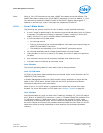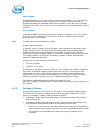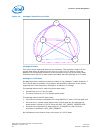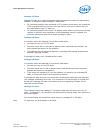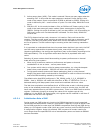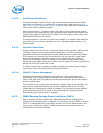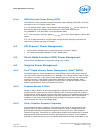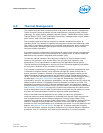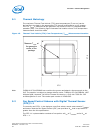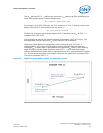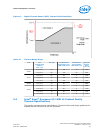
4.3.2.2 Conditional Self-Refresh
During S0 idle state, system memory may be conditionally placed into self-refresh
state when the processor is in package C3 or deeper power state. Refer to Intel®
Rapid Memory Power Management (Intel® RMPM) for more details on conditional self-
refresh with Intel HD Graphics enabled.
When entering the S3 – Suspend-to-RAM (STR) state or S0 conditional self-refresh,
the processor core flushes pending cycles and then enters SDRAM ranks that are not
used by Intel graphics memory into self-refresh. The CKE signals remain LOW so the
SDRAM devices perform self-refresh.
The target behavior is to enter self-refresh for package C3 or deeper power states as
long as there are no memory requests to service. The target usage is shown in the
following table.
4.3.2.3 Dynamic Power-Down
Dynamic power-down of memory is employed during normal operation. Based on idle
conditions, a given memory rank may be powered down. The IMC implements
aggressive CKE control to dynamically put the DRAM devices in a power-down state.
The processor core controller can be configured to put the devices in active power-
down (CKE de-assertion with open pages) or pre-charge power-down (CKE de-
assertion with all pages closed). Pre-charge power-down provides greater power
savings but has a bigger performance impact, since all pages will first be closed before
putting the devices in power-down mode.
If dynamic power-down is enabled, all ranks are powered up before doing a refresh
cycle and all ranks are powered down at the end of refresh.
4.3.2.4 DRAM I/O Power Management
Unused signals should be disabled to save power and reduce electromagnetic
interference. This includes all signals associated with an unused memory channel.
Clocks, CKE, ODE, and CS signals are controlled per DIMM rank and will be powered
down for unused ranks.
The I/O buffer for an unused signal should be tri-stated (output driver disabled), the
input receiver (differential sense-amp) should be disabled, and any DLL circuitry
related ONLY to unused signals should be disabled. The input path must be gated to
prevent spurious results due to noise on the unused signals (typically handled
automatically when input receiver is disabled).
4.3.3
DRAM Running Average Power Limitation (RAPL)
RAPL is a power and time constant pair. DRAM RAPL defines an average power
constraint for the DRAM domain. Constraint is controlled by the PCU. Platform entities
(PECI or in-band power driver) can specify a power limit for the DRAM domain. PCU
continuously monitors the extant of DRAM throttling due to the power limit and
rebudgets the limit between DIMMs.
Processor—Power Management
Intel
®
Xeon
®
Processor E3-1200 v3 Product Family
Datasheet – Volume 1 of 2 June 2013
60 Order No.: 328907-001




